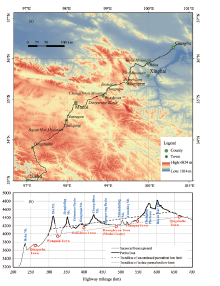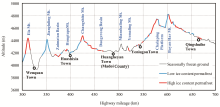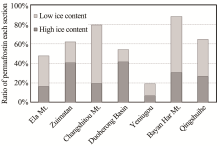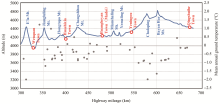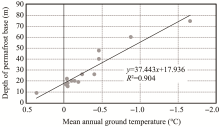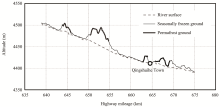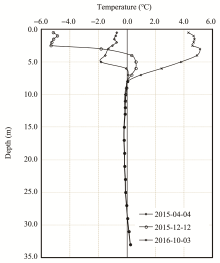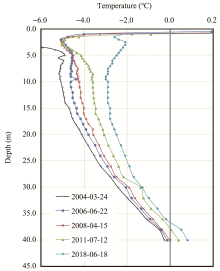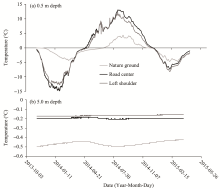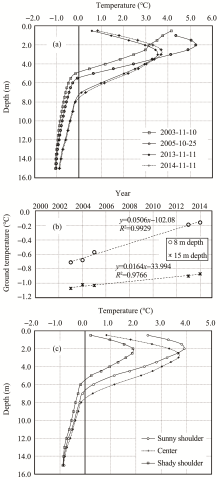Sciences in Cold and Arid Regions ›› 2020, Vol. 12 ›› Issue (6): 503–516.doi: 10.3724/SP.J.1226.2020.00503
• • 上一篇
Characteristics and changes of permafrost along the engineering corridor of National Highway 214 in the eastern Qinghai-Tibet Plateau
Yu Sheng1,JiChun Wu1,Wei Cao1( ),JianHong Fang2,AnHua Xu2,ErXing Peng1
),JianHong Fang2,AnHua Xu2,ErXing Peng1
- 1.State Key Laboratory of Frozen Soil Engineering, Northwest Institute of Eco-Environment and Resources, Chinese Academy of Sciences, Lanzhou, Gansu 730000, China
2.Institute of Transportation Sciences of Qinghai Province, Xining, Qinghai 810003, China
| Chen J, Feng ZL, Sheng Y, et al., 2014. Permafrost along National Highway 214 and its engineering geological condition evaluation. Journal of Glaciology and Geocryology, 36(4): 790-801. | |
| Cheng GD, 1984. Problems on zonation of high-altitude permafrost. Acta Geographic Sinica, 39(2): 186-193. | |
|
Cheng GD, Wu TH, 2007. Responses of permafrost to climate change and their environmental significant, Qinghai-Tibet Plateau. Journal of Geophysical Research, 112: F02S03. DOI: 10.1029/2006/JF000631.
doi: 10.1029/2006/JF000631 |
|
| Cheng GD, Zhao L, 2000. The problems associated with permafrost in the development of the Qinghai-Xizang Plateau. Quaternary Sciences, 20(6): 521-531. (in Chinese) | |
| Chou YL, Sheng Y, Ma W, 2008. Study on the effect of the thermal regime differences in roadbed slopes on their thawing features in permafrost regions on Qinghai-Tibet Plateau. Cold Region Science and Technology, 53: 334-345. | |
| Dong YH, Chen JB, Yuan K, et al., 2020. A field embankment test along the Gonghe-Yushu Expressway in the permafrost regions of the Qinghai-Tibet Plateau. Cold Region Science and Technology, 170: 102941. . | |
| Fang JH, 2011. Engineering effect of crushed rock revement of embankments with asphalt and concrete pavements along the National Highway 214. Journal of Glaciology and Geocryology, 33(6): 1316-1322. | |
| Fang JH, Liu JK, 2016. Analysis of long-term changes for thermal regime of permafrost underlying subgrade along National Highway G214. China Journal of Highway and Transport, 29(11): 25-32. | |
| Jin HJ, Sun LP, Wang SL, et al., 2008. Dual influence of local environmental variables on ground temperature on the interior-eastern Qinghai-Tibet Plateau (I): vegetation and snow cover. Journal of Glaciology and Geocryology, 30(4): 535-545. | |
| Jin HJ, Wang SL, Lü LZ, et al., 2010. Features and degradation of frozen ground in the sources area of the Yellow River, China. Journal of Glaciology and Geocryology, 32(1): 10-17. | |
| Jin HJ, Zhao L, Wang SL, et al., 2006. Degradation modes and ground temperature of permafrost along the Qinghai-Tibet Highway. Science China: Earth Science, 49(11): 1170-1183. | |
| Jorgenson MT, Racine CH, Walters JC, et al., 2001. Permafrost degradation and ecological change associated with a warming climate in central Alaska. Climate Change, 48: 551-557. | |
| Li JP, Sheng Y, Zhang JZ, 2010. Study on diseases of cement of concrete pavement in permafrost regions. Cold Regions Science and Technology, 60(1): 57-62. | |
| Liang SH, Wan L, Li ZM, et al., 2007. The effect of permafrost on alpine vegetation in the source regions of the Yellow River. Journal of Glaciology and Geocryology, 29(1): 45-52. | |
| Lin ZY, Wu XD, 1981. Climatic regionalization of the Qinghai-Xizang Plateau. Acta Geographic Sinica, 36(1): 22-32. | |
| Liu DP, Wang SJ, Jin L, et al., 2013. Engineering geological characteristics of the permafrost and degradation analysis of National Road 214. Subgrade Engineering, (1): 1-5. | |
| Liu GY, Wang W, Zhao L, et al., 2015. Using transient electromagnetic method to sound permafrost depth in the West Kunlun Mountains. Journal of Glaciology and Geocryology, 37(1): 38-48. | |
| Liu JK, Tai BW, Fang JH, 2019. Ground temperature and deformation analysis for an expressway embankment in warm permafrost regions of the Tibet Plateau. Permafrost and Periglacial Processes, 30(3): 208-221. | |
| Liu YZ, Wu QB, Zhang JM, et al., 2002. Deformation of highway roadbed in permafrost regions of the Tibetan Plateau. Journal of Glaciology and Geocryology, 24(1): 10-15. | |
| Luo DL, Jin HJ, Lin L, et al., 2012. Degradation of permafrost and cold-environments on the interior and eastern Qinghai Plateau. Journal of Glaciology and Geocryology, 34(3): 538-546. | |
|
Ma W, Mu YH, Xie SB, et al., 2017. Thermal-mechanical influences and environmental effects of expressway construction on the Qinghai-Tibet permafrost engineering corridor. Advances in Earth Sciene, 32(5): 4569-464. DOI: 10. 11876/j.issn.1001-8166.2017.05.0459.
doi: 10. 11876/j.issn.1001-8166.2017.05.0459 |
|
| Mu YH, Ma W, Niu FJ, et al., 2014. Study on geotechnical hazards to roadway engineering in permafrost regions. Journal of Disaster Prevention and Mitigation Engineering, 34(3): 259-267. | |
| Nelson FE, Anisimov OE, Shiklomanov NI, 2002. Climate change and hazard zonation in the circum-Arctic permafrost regions. Nature Hazards, 26: 203-225. | |
| Pang QQ, Zhao L, Li SX, 2011. Influence of local factors on ground temperatures in permafrost regions along the Qinghai-Tibet Highway. Journal of Glaciology and Geocryology, 33(2): 349-356. | |
|
Sheng Y, Cao YB, Li J, et al., 2015. Characteristic of permafrost along Highway G214 in the eastern Qinghai-Tibet Plateau. Journal of Mountain Science, 12(5): 1135-1144. DOI: 10.1007/s11629-014-3207-x.
doi: 10.1007/s11629-014-3207-x |
|
| Sheng Y, Zhang JM, Liu YZ, et al., 2002. Thermal regime in the embankment of Qinghai-Tibet Highway in permafrost regions. Cold Regions Science and Technology, 35: 35-44. | |
| Tai BW, Liu JK, Chang D, 2020. Experimental and numerical investigation on the sunny-shady slopes effect of three cooling embankments along an expressway in warm permafrost region, China. Engineering Geology, 269: 105545. | |
| Wang NL, 2006. The boundary between the northern and southern Tibetan Plateau with different variations in the warm season air temperatures on the decadal time scale. Quaternary Science, 26(2): 165-172. | |
| Wang SL, Lin Q, Zhao L, 1999. Permafrost along the Qing-Kang Highway (National Highway No.214). Arid Land Geography, 22(2): 42-49. | |
| Wen Z, Sheng Y, Ma W, et al., 2009. Ground temperature and deformation laws of highway embankments in degenerative permafrost regions. Chinese Journal of Rock Mechanics and Engineering, 28(7): 1477-1483. | |
|
Wu JC, Sheng Y, Cao YB, et al., 2015. Discovery of large frost mound clusters in the source regions of the Yellow River on the Tibetan Plateau. Journal of Glaciology and Geocryology, 37(5): 1217-1228. DOI: 10.7522/j.isnn.1000-0240. 2015.0136.
doi: 10.7522/j.isnn.1000-0240. 2015.0136 |
|
| Wu JC, Sheng Y, Wu QB, et al., 2010. Processes and mode of permafrost degradation on the Qinghai-Tibet Plateau. Science in China (Series D), 53(1): 150-158. | |
| Wu JM, Wang SJ, Zhang JZ, 2005. The Highway Engineering on Permafrost Regions. Beijing: China Communication Press. | |
| Wu QB, Liu YZ, Hu ZY, et al., 2011. The thermal effect of differential solar exposure on embankment along the Qinghai-Tibet Railway. Cold Regions Science and Technology, 66: 30-38. | |
| Wu QB, Liu YZ, Zhu YL, 2001. Thermal state of active layer under asphalt pavement of Qinghai-Tibet Highway. Journal of Xi'an Highway University, 21(1): 23-25. | |
|
Wu QB, Niu FJ, 2013. Permafrost changes and engineering stability in Qinghai-Xizang Plateau. Chinese Science Bulletin, 58: 1079-1094. DOI: 10.1007/s11434-012-5587-z.
doi: 10.1007/s11434-012-5587-z |
|
|
Wu QB, Zhang TJ, 2008. Recent permafrost warming on the Qinghai-Tibetan Plateau. Journal of Geophysical Research, 113: D13108. DOI :10.1029/2007JD009539.
doi: 10.1029/2007JD009539 |
|
| Yao ZY, Li XY, Dong ZB, 2015. Causes and processes of desertification in Madoi County in the source regions of the Yellow River. Journal of Glaciology and Geocryology, 37(5): 1245-1256. | |
| Yong GWC, Li DQ, Zhang K, et al., 2010. Characteristic analysis on pavement disease in National Highway 214 in the permafrost region. Journal of Highway and Transportation Research and Development: Application Version, 6(2): 34-38. | |
| Zhang SQ, Wang YG, Zhao YZ, et al., 2004. Degradation of permafrost in the sources of the Yellow River and its environmental impacts. Journal of Glaciology and Geocryology, 26(1): 1-6. | |
|
Zhang ZQ, Wu QB, Wen Z, et al., 2015. Analysis of the radiation characteristics on asphalt pavement in Beiluhe section in the Tibetan Plateau. Journal of Glacioloy and Geocryology, 37(2): 408-416. DOI: 10.7522/j.issn.1000-0240.2015. 0045.
doi: 10.7522/j.issn.1000-0240.2015. 0045 |
|
| Zhao XQ, Li XJ, Yao W, et al., 2011. Engineering geological evaluation of the permafrost from Kuhaitan to Huangheyan along the G214 line. Journal of Glaciology and Geocryology, 33(4): 902-907. | |
| Zhou YW, Qiu GQ, Guo DX, et al., 2000. Geocryology in China. Beijing: Science Press. | |
| Zhu LN, Wu ZW, Liu YZ, 1995a. Permafrost degradation in the east of Tibetan Plateau. Journal of Glaciology and Geocryology, 17(2): 120-124. | |
| Zhu LN, Wu ZW, Liu YZ, et al., 1995b. Effects of permafrost degradation on environment in the east of Qinghai-Xizang (Tibet) Plateau. Marine Geology & Quaternary Geology, 15(3): 129-136. |
| No related articles found! |

